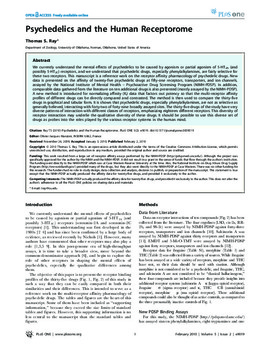| dc.contributor.author | Thomas S. Ray | en_US |
| dc.date.accessioned | 2015-01-23T17:17:29Z | |
| dc.date.accessioned | 2016-03-30T15:35:48Z | |
| dc.date.available | 2015-01-23T17:17:29Z | |
| dc.date.available | 2016-03-30T15:35:48Z | |
| dc.date.issued | 2010-02-02 | en_US |
| dc.identifier.citation | Ray TS (2010) Psychedelics and the Human Receptorome. PLoS ONE 5(2): e9019. doi:10.1371/journal.pone.0009019 | en_US |
| dc.identifier.uri | https://hdl.handle.net/11244/14061 | |
| dc.description | I acknowledge Chenmei Xu for preparing the figures for this manuscript. | en_US |
| dc.description | Conceived and designed the experiments: TR. Analyzed the data: TR. Contributed reagents/materials/analysis tools: TR. Wrote the paper: TR. | en_US |
| dc.description.abstract | We currently understand the mental effects of psychedelics to be caused by agonism or partial agonism of 5-HT2A (and possibly 5-HT2C) receptors, and we understand that psychedelic drugs, especially phenylalkylamines, are fairly selective for these two receptors. This manuscript is a reference work on the receptor affinity pharmacology of psychedelic drugs. New data is presented on the affinity of twenty-five psychedelic drugs at fifty-one receptors, transporters, and ion channels, assayed by the National Institute of Mental Health – Psychoactive Drug Screening Program (NIMH-PDSP). In addition, comparable data gathered from the literature on ten additional drugs is also presented (mostly assayed by the NIMH-PDSP). A new method is introduced for normalizing affinity (Ki) data that factors out potency so that the multi-receptor affinity profiles of different drugs can be directly compared and contrasted. The method is then used to compare the thirty-five drugs in graphical and tabular form. It is shown that psychedelic drugs, especially phenylalkylamines, are not as selective as generally believed, interacting with forty-two of forty-nine broadly assayed sites. The thirty-five drugs of the study have very diverse patterns of interaction with different classes of receptors, emphasizing eighteen different receptors. This diversity of receptor interaction may underlie the qualitative diversity of these drugs. It should be possible to use this diverse set of drugs as probes into the roles played by the various receptor systems in the human mind. | en_US |
| dc.language.iso | en_US | en_US |
| dc.publisher | PLos One | en_US |
| dc.relation.ispartofseries | PLoS ONE 5(2):e9019 | en_US |
| dc.relation.uri | http://www.plosone.org/article/info%3Adoi%2F10.1371%2Fjournal.pone.0009019 | en_US |
| dc.rights | Attribution 3.0 United States | en_US |
| dc.rights.uri | https://creativecommons.org/licenses/by/3.0/us/ | en_US |
| dc.subject | PLOS | en_US |
| dc.subject | Public Library of Science | en_US |
| dc.subject | Open Access | en_US |
| dc.subject | Open-Access | en_US |
| dc.subject | Science | en_US |
| dc.subject | Medicine | en_US |
| dc.subject | Biology | en_US |
| dc.subject | Research | en_US |
| dc.subject | Peer-review | en_US |
| dc.subject | Inclusive | en_US |
| dc.subject | Interdisciplinary | en_US |
| dc.subject | Ante-disciplinary | en_US |
| dc.subject | Physics | en_US |
| dc.subject | Chemistry | en_US |
| dc.subject | Engineering | en_US |
| dc.title | Psychedelics and the Human Receptorome | en_US |
| dc.type | Research Article | en_US |
| dc.description.peerreview | Yes | en_US |
| dc.description.peerreviewnotes | http://www.plosone.org/static/editorial#peer | en_US |
| dc.identifier.doi | 10.1371/journal.pone.0009019 | en_US |
| dc.rights.requestable | false | en_US |

